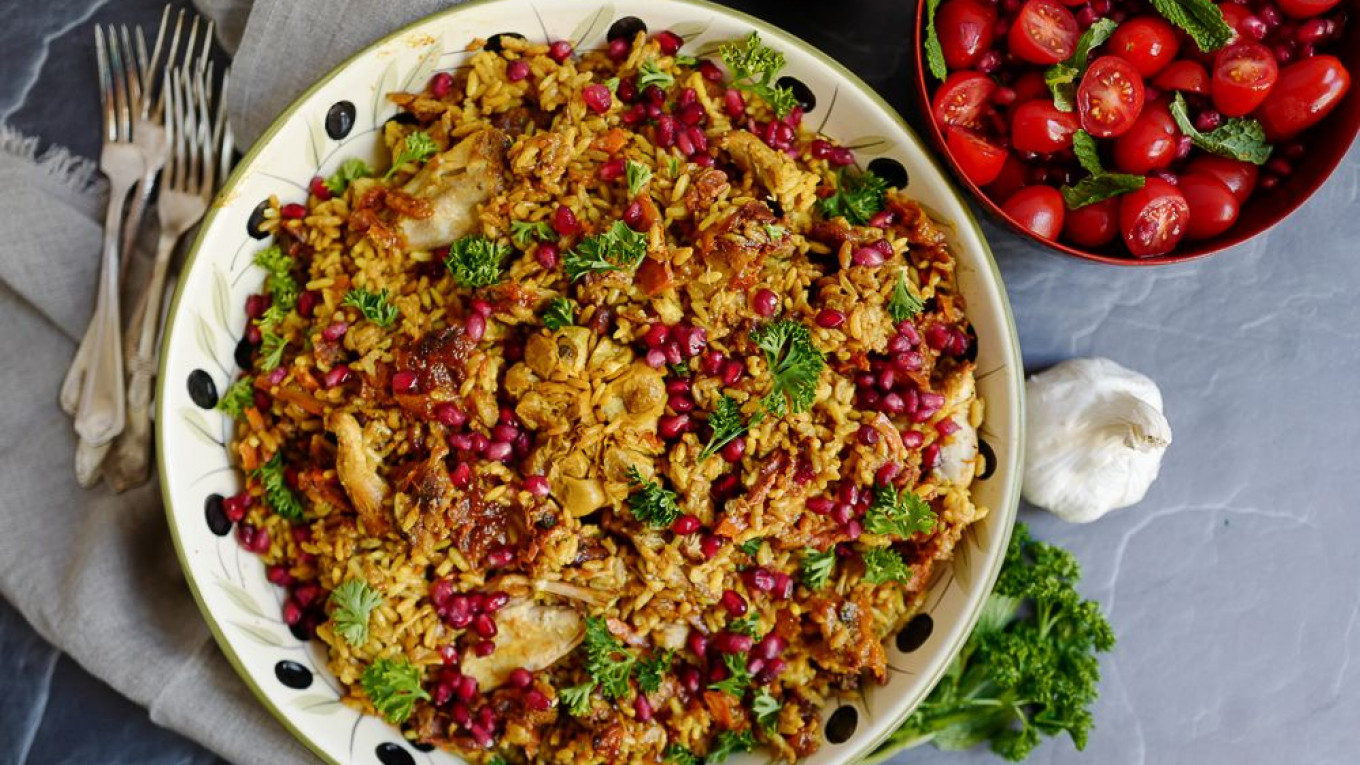It has been a dog of a week!
First: the American election. Next: appliances then went on what was clearly a coordinated sympathy strike: the stand mixture, the icemaker, and the stove’s pilot light all stopped working. And then my dog got sick. The vets sent us home with medication and instructions to keep our young Lab on a “bland diet” for a few days.
“What kind of bland diet?” asked one of my Twitter friends.
“Rice and chicken,” I typed back.
“Plov,” he responded, “they have prescribed your dog plov.”
My friend has a passion for plov, the national dish of Uzbekistan. This hearty pilaf or pilau of rice, vegetables, spices, and meat is the centerpiece of any major event in Central Asia such as weddings or national holidays and earned the coveted distinction of a UNESCO intangible cultural heritage of humanity in 2016. Served on a large communal platter or tray, plov has been an enduring symbol of hospitality and community for over 1000 years, not only in its native Central Asia, but throughout the post-Soviet space. Plov can be made with lamb, beef, fish, vegetables, and fruits, and, of course, chicken; pork is also an option, but not popular in primarily Muslim Central Asia.
Uzbekistan’s long association with the Russian empire has made plov as much a part of the ecumenical Russian diet as cabbage soup and beef stroganoff. Russians relish plov in all settings: spooning it from a plastic dish at an outdoor festival or enjoying a gourmet plov at upscale Uzbek restaurants throughout the country. My friend Svetlana makes epic plov out at her dacha, fluffing the rice by burying it underground.
Plov would fit the bill admirably for both dog and humans. But making plov is usually a fiddly, all-day cooking project. There are a lot of moving parts to plov, requiring both patience and stamina, which may be the reason that the Uzbeks only got around to letting women make plov after the Russian Revolution of 1917. If you want to do the thing thoroughly, you need kurdiuk, the fat from the tail of a sheep which isn’t always available at the local supermarket. Even if you substitute oil for the kurdiuk, there is still a great deal of slicing and dicing (which I imagine the Uzbek men may have allowed the Uzbek women do as a very special treat even before the Revolution).
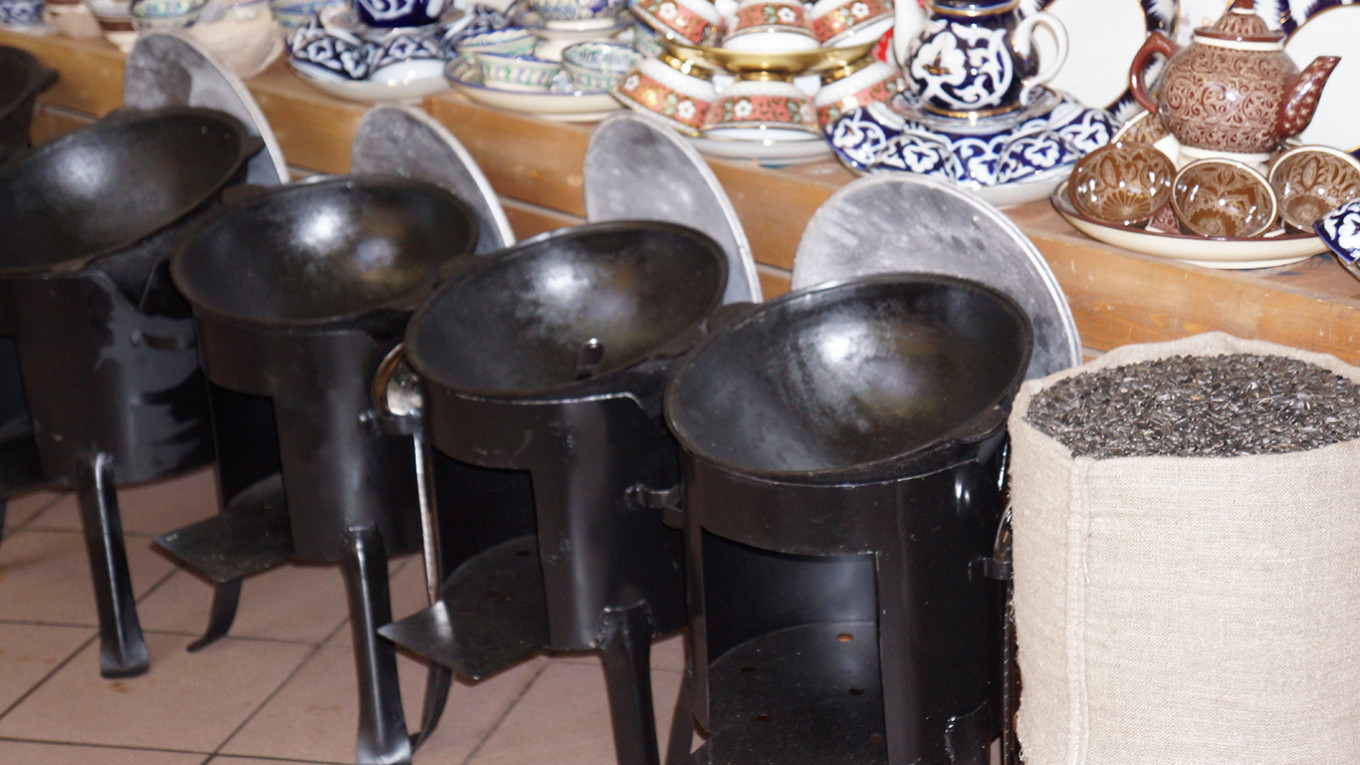
The traditional method of making plov involves a large, round bottomed pot called a kazan. After melting the kurdiuk, the plov chef sweats onions and garlic, then browns meat. On top of these, matchstick carrots and other vegetables are sauteed with a spice mixture called zirvak. Rice is then smoothed over the ingredients and liquid added very carefully so as not to dislodge the carefully constructed layers. Then the mixture is cooked on very low heat for quite some time until the liquid evaporates completely. And you have to keep your eye on it while it cooks.
With all the fiddling, slicing, and dicing, and with no kurdiuk to hand, I thought plov was firmly in the “one-too-many” category as I measured out rice, water and chicken thighs in the Instapot insert for my dog’s bland diet.
And as I pressed the multi cooker buttons to the “rice” function, the Instapot struck me as potentially an ideal plov maker. This miracle multi cooker was invented by immigrants for immigrants to Canada, one magic pot that could fill the gaping chasm in cooking facilities in the immigrants’ adopted countries. Instapots are pressure cookers, slow cookers, yogurt makers, rice cookers, and can also act as a saucepan for sautés, a braising pot for stews, and even sous vide. I make several batches of stock in it each week, lots of Greek yogurt and labneh, I cook our weekly buckwheat ration in it, I warm up leftovers, steam vegetables, and make all kinds of stews, risottos, and lots of beans and lentil dishes.
But can you make plov in the Instapot?
Yes, you can. Okay, it’s not quite the plov I’ve enjoyed in Uzbekistan, where I first fell in love with the jewel tones of rice and dried fruits served on the elaborately decorated plov platters. But the plov I made in the Instapot has the right flavors at work and almost a perfect texture. Best of all: it’s hand’s off.
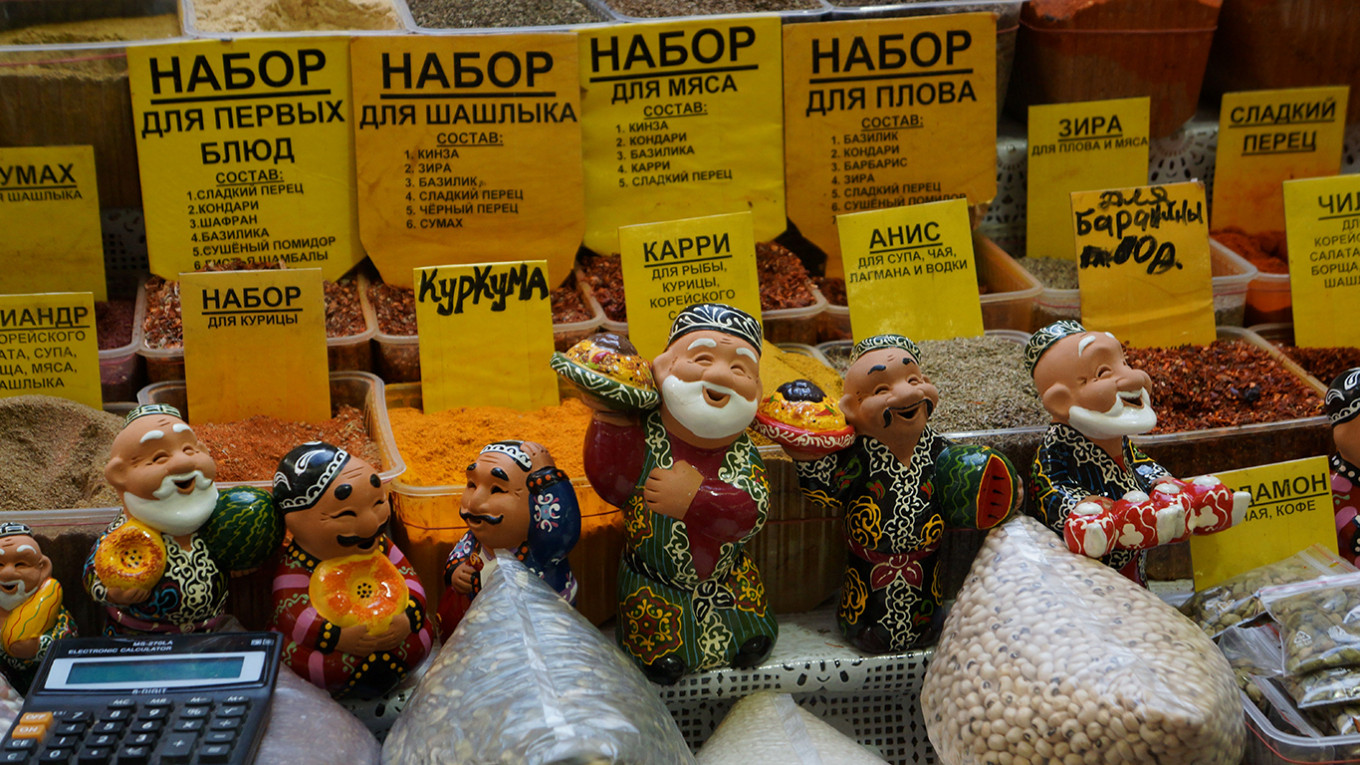
The recipe below uses chicken thighs, which are the best cut of poultry to use in plov as they won’t dry out, but you can substitute lamb or beef. I used chicken schmaltz instead of the elusive kurdiuk to sear the meat and sauté the onions and vegetables and it added a deep, chicken-y flavor. I like plovs that combine fruits with the vegetables, and for this recipe, I used quince, which is currently in season, but tart apples are excellent substitutes. Barberries or sour cherries and apricots give the plov a nice sweet undertone and contrast to the carrots and onions. Most plov recipes call for an entire head of garlic, which is cut in half and then nestled into the rice. Don’t omit this step! While cooking, the garlic’s strong flavor mellows, and the sweet and pungent cloves are an essential part of the final flavor.
Plov needs little alongside it, though I do like to serve it with a salad of cherry tomatoes tossed with salt, olive oil, lemon juice, and chopped mint. When available, I garnish with plov with pomegranate seeds, but more dried fruit is also a great way to make the dish more festive.
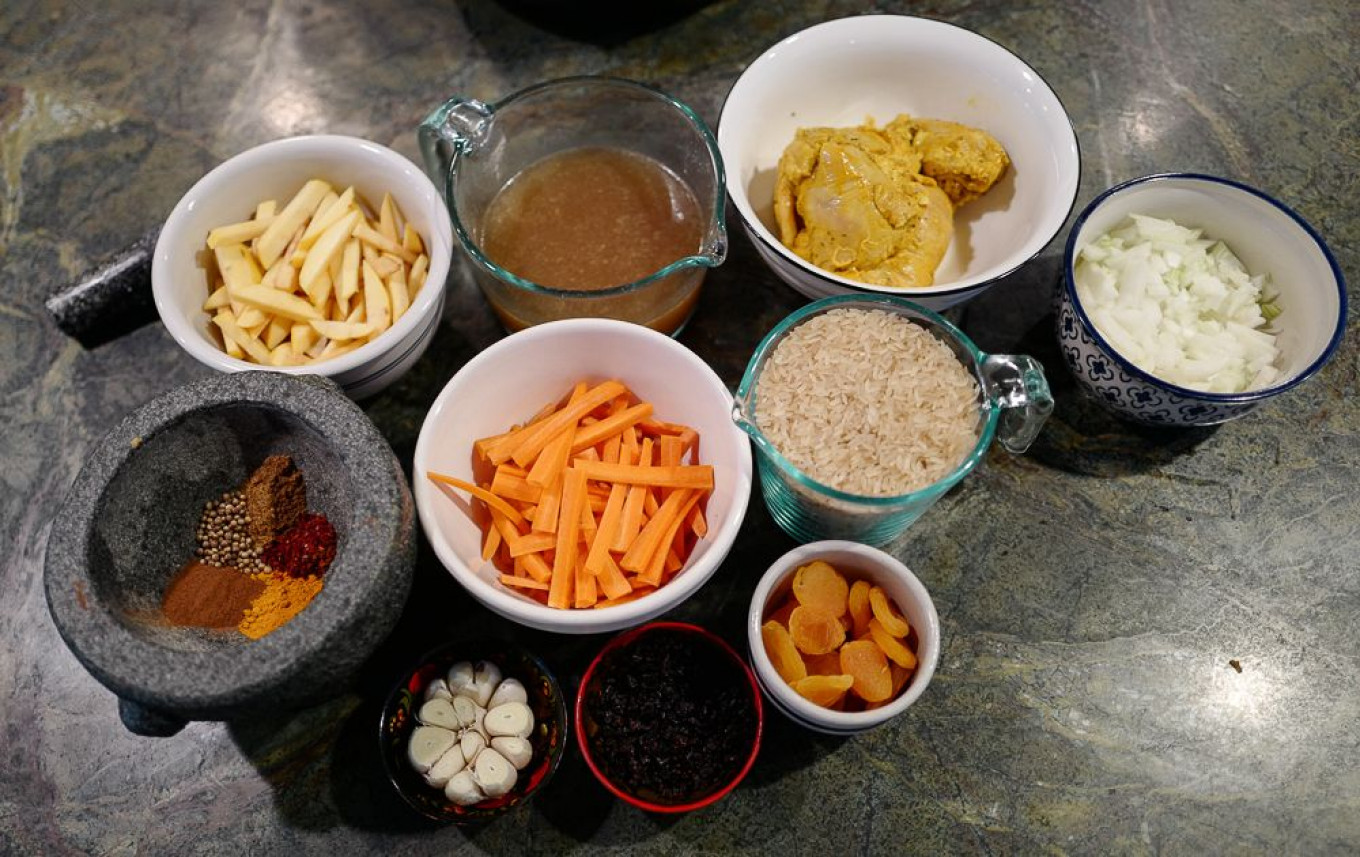
Insta-plov: Uzbek plov made in the Instapot
Ingredients
For the chicken
- 2 lbs. (900 grams) boneless, skinless chicken thighs
- 2 tsp turmeric
- 1 tsp red pepper
- 2 tsp salt
- Juice of one lime
- 3 Tbsp olive oil
For the rice and vegetables
- 2 cups (475 ml) rice*
- 2 tsp salt
- 1 yellow onion, finely diced
- 2 Tbsp chicken schmaltz or Grapeseed oil
- 2 ¾ cups (650 ml) chicken stock or water
- 1 head of garlic (if you are a real garlic lover, go ahead and use 2!)
- 4-5 medium-sized carrots, peeled and cut into 2-inch matchsticks
- 2-3 quinces, cored and sliced into 2-inch matchsticks
- 1 cup (240 ml) dried apricots
- ½ cup (120 ml) barberries or sour cherries or dried cranberries
For the zirvak
- 1 tsp ground cumin
- 1 tsp ground coriander or 2 tsp coriander seeds
- 1 tsp cinnamon
- 2 tsp turmeric
- 1 tsp salt
- 1 tsp Aleppo pepper or paprika
For the garnish
- ½ cup (120 ml) fresh pomegranate seeds
- Chopped fresh herbs such as mint and/or parsley
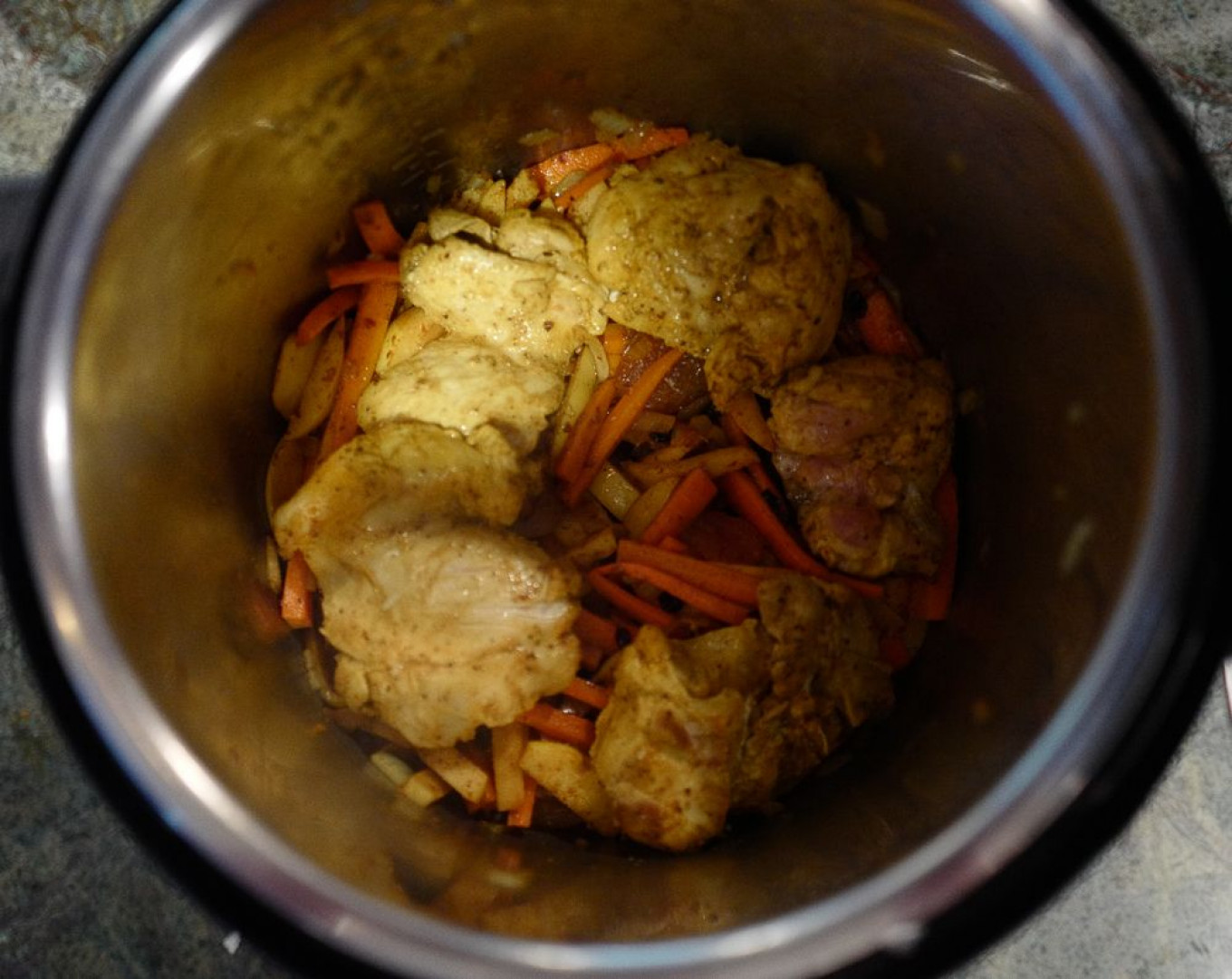
Instructions
- Combine the chicken thighs with the marinade ingredients in a sturdy plastic bag and let stand for at least 2 hours — but better overnight. When ready to cook, pat the chicken thighs dry with paper towels.
- Select the “sauté” function on the Instapot for 20 minutes. Add the chicken schmaltz to the pot and when it begins to spit, add the chicken thighs and sear them on both sides until browned (about 2-3 minutes per side). Remove the chicken to a plate and tent with foil.
- Add the onion to the Instapot and sauté until limp. Add the carrots and quince matchsticks and the zirvak and toss to combine as you cook the mixture for 3 minutes, making sure that the spices are evenly distributed.
- Turn off the Instapot and add the apricots and barberries. Cover the Instapot and let sit for 6 minutes.
- Rinse the rice in a colander. Carefully place the chicken thighs on top of the vegetable mixture, then smooth the rice over the top and sprinkle the 2 tsp salt evenly over the surface. Nestle the garlic head into the center of the plov so that the cut side is facing down. Then pour the liquid slowly and carefully down the side of the Instapot, so that the layers stay in place. If the liquid does not cover all the rice, add up to ¾ cup more so that it covers the rice.
- Secure the lid on the Instapot. Then set the pressure option to “high” (on some Instapots this is called “manual”) for 12 minutes. Note the time that the active cooking finishes and allow the pot to have a “natural release.” Leave it alone so that the built-up pressure releases on its own. When 15 minutes is up, release the remaining pressure by flipping the seal for a manual release.
- Open the pot carefully. Use the end of a wooden spoon to poke several holes into the surface of the plov, then replace the lid of the Instapot and allow the plov to sit for another 5 minutes.
- Note: you may need to fluff up the rice at this point, which isn’t part of the plov tradition, but is advisable for rice dishes made in the Instapot. If the rice is slightly underdone, let it sit for another 5 minutes.
- Remove the head of garlic with tongs and when it is cool, pull the cloves from the husk. Then spoon the plov onto a serving platter: rice first, then chicken, then vegetables. Top with the garlic cloves, chopped fresh herbs and pomegranate seeds. The chicken will have turned silky and broken up into chunks.
*Recipe Note: Plov rice, which is widely available in Russia, is a short-grain rice similar to arborio or Japanese sushi rice; I’ve used both for plov made in a conventional pot and they worked very well. Some recipes advise basmati or jasmine rice, which I find is too flimsy for the robust job the rice has to do in plov. Since Insta-plov was inspired by using what I had on hand, I used regular long grain rice, which worked well.
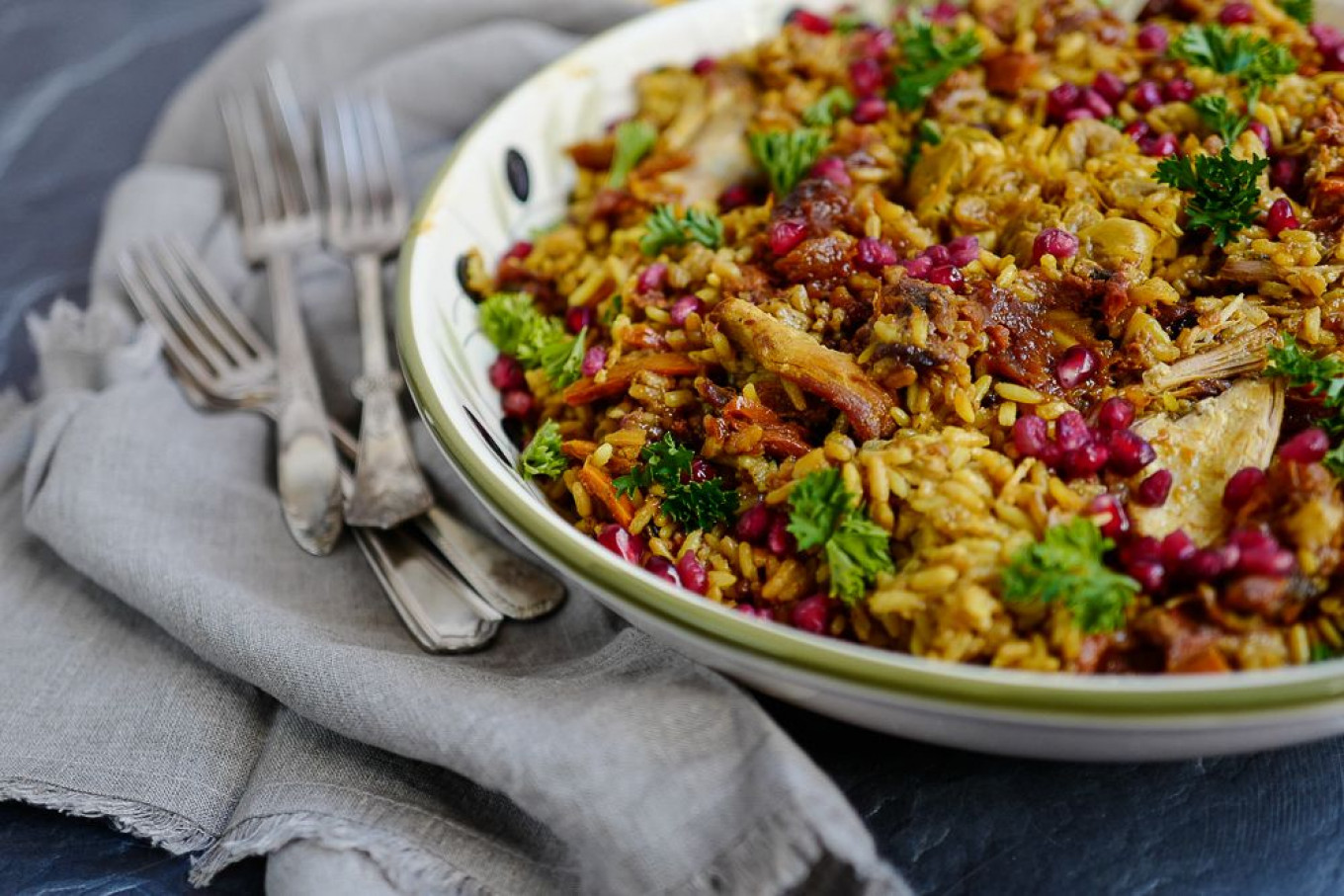
A Message from The Moscow Times:
Dear readers,
We are facing unprecedented challenges. Russia's Prosecutor General's Office has designated The Moscow Times as an "undesirable" organization, criminalizing our work and putting our staff at risk of prosecution. This follows our earlier unjust labeling as a "foreign agent."
These actions are direct attempts to silence independent journalism in Russia. The authorities claim our work "discredits the decisions of the Russian leadership." We see things differently: we strive to provide accurate, unbiased reporting on Russia.
We, the journalists of The Moscow Times, refuse to be silenced. But to continue our work, we need your help.
Your support, no matter how small, makes a world of difference. If you can, please support us monthly starting from just $2. It's quick to set up, and every contribution makes a significant impact.
By supporting The Moscow Times, you're defending open, independent journalism in the face of repression. Thank you for standing with us.
Remind me later.



